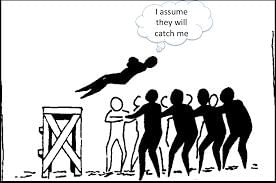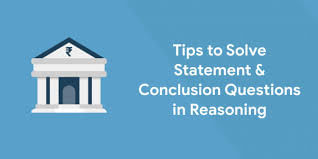Overview: Statement and Assumptions | Reasoning Aptitude for Competitive Examinations - Bank Exams PDF Download
| Table of contents |

|
| Introduction |

|
| Concept of Statement & Assumption |

|
| Tips To Solve Statement & Reasoning Questions |

|
| Solved Examples |

|
Introduction
- The subject of 'statements and assumptions' holds significant prominence in numerous competitive exams, constituting a vital segment of the Government exam syllabus. These questions primarily aim to evaluate the decision-making skills of candidates.
- In various Government exams, candidates can expect to encounter anywhere from 1 to 5 questions related to statements and assumptions. Notably, these questions are not only time-saving but also require logical explanations.
- For a comprehensive understanding of the logical reasoning syllabus, interested candidates can refer to the linked article, which provides a detailed list of topics encompassed in the reasoning ability section. It is crucial to acknowledge that the competition for Government sector jobs has surged over the years, with millions of candidates participating annually.
Consequently, preparation for these exams demands thoroughness due to the extensive and wide-ranging syllabus. To excel in the examination, candidates should adopt a systematic approach, delving into each subject and gaining an in-depth understanding of every topic within the respective sections. - Specifically addressing 'statements and assumptions,' we offer an elaborate exploration of the concept, accompanied by practical tips to facilitate an easier and more engaging comprehension of the topic.
Additionally, the article includes sample questions pertaining to statements and assumptions for further clarification. - Aspirants are encouraged to explore the reasoning ability section's article for insights into the 'statement and conclusion' topic, allowing them to discern the distinctions between these two concepts during their preparation.

Concept of Statement & Assumption
- In a statement and assumption question, a statement is given in the question followed by a few assumptions made on the basis of them.
- Candidates need to pick the assumption which most appropriately and logically is correct.
- Questions based on statement and assumption can either help you score more if answered logically or else result in losing marks if candidates choose to guess in such questions.
- Thus more and more questions must be solved so as to ensure that you are able to understand what is the correct approach to such questions.
- Assumption: One of the most important things to know about assumptions is that when a statement is given, the author of the statement believes the assumption to be true and this same approach must be used by candidates while answering the questions based on this topic.

Tips To Solve Statement & Reasoning Questions
- Approach statement and assumption questions by considering assumptions to be true in relation to the statement.
- Avoid overly complex reasoning; analyze the information provided in the statement and base assumptions solely on that information.
- Stick to common assumptions, and refrain from aligning the statement with general knowledge or unrelated facts.
- If uncertain about the answer, employ the elimination method. Evaluate the statement and compare assumptions provided in the options, eliminating those that clearly do not align. Choose from the remaining options for a more straightforward decision.
- Keep in mind that an assumption is something the author believes to be true. When selecting the correct option, ensure it aligns with the statement, as any contradiction indicates an incorrect assumption.
- Aspirants should practice solving statement and assumption questions using this approach and self-analyze whether these tips prove helpful or not.
Solved Examples
Discussed below are a few such examples and sample questions to help you understand the concept even better and also to let you analyse the pattern in which the questions may be asked.
Q1: Statement: The advisable age for a child to join a school is 5 years.
Assumption I: At this age, the child is familiar to adaptability
Assumption II: After this age, kids do not like to go to school
Assumption III: Schools do not take admission of children who are more than 5 years old
(a) Only Assumption I follows
(b) Both Assumptions I & III follow
(c) Assumption I, II & III follow
(d) Only Assumption II follows
(e) None of the Above
Ans: (a)
Sol: In the given statement it is mentioned that 5 years is an advisable age for kids to join the school. The only sensible assumption which proves the statement to be true is that chances of kids getting more adaptable to the school at this young age are very high.
Q2: Statement: Food poisoning due to the consumption of liquor is very common in rural areas
Assumption I: There are more illegal and unauthorised shops selling liquor in villages and rural areas
Assumption II: The ratio of people drinking liquor in villages is much more than that in towns
(a) Both Assumption I and II follow
(b) Neither Assumption I nor Assumption II follows
(c) Only Assumption I follows
(d) Assumption II follows but Assumption I does not follow
(e) Either Assumption I or Assumption II follows
Ans: (c)
Sol: The statement is talking about food poisoning due to liquor so the number of people consuming liquor in towns or villages is not the main concern here. Which is why the only assumption I follow
Q3: Statement: Divya was advised by the Doctor that she should not take part in the dance competition
Assumption I: The Doctor did not want Divya to take part in the competition because he was afraid that she might lose
Assumption II: Divya had major surgery because of her injury
Assumption III: Divya did not have the money to go for the auditions
(a) All Assumption I, II & III follow
(b) Only Assumption I follows
(c) Assumption II follows but Assumption I and III do not follow
(d) None of the three assumptions follow
(e) Only Assumption III follows
Ans: (c)
Sol: Based on the statement given, the Doctor would only advice a patient to not do certain things if they are unwell, in this case surgery. Which is the only suitable assumption why the doctor would advise Divya to not take part in the dance competition
|
72 videos|112 docs|113 tests
|
FAQs on Overview: Statement and Assumptions - Reasoning Aptitude for Competitive Examinations - Bank Exams
| 1. What is the concept of Statement & Assumption in reasoning? |  |
| 2. How can Statement & Reasoning questions be solved effectively? |  |
| 3. Can you provide an example of Statement & Assumption? |  |
| 4. How do statement and assumption questions appear in the CAT exam? |  |
| 5. What are some commonly searched topics related to Statement & Assumption? |  |




















